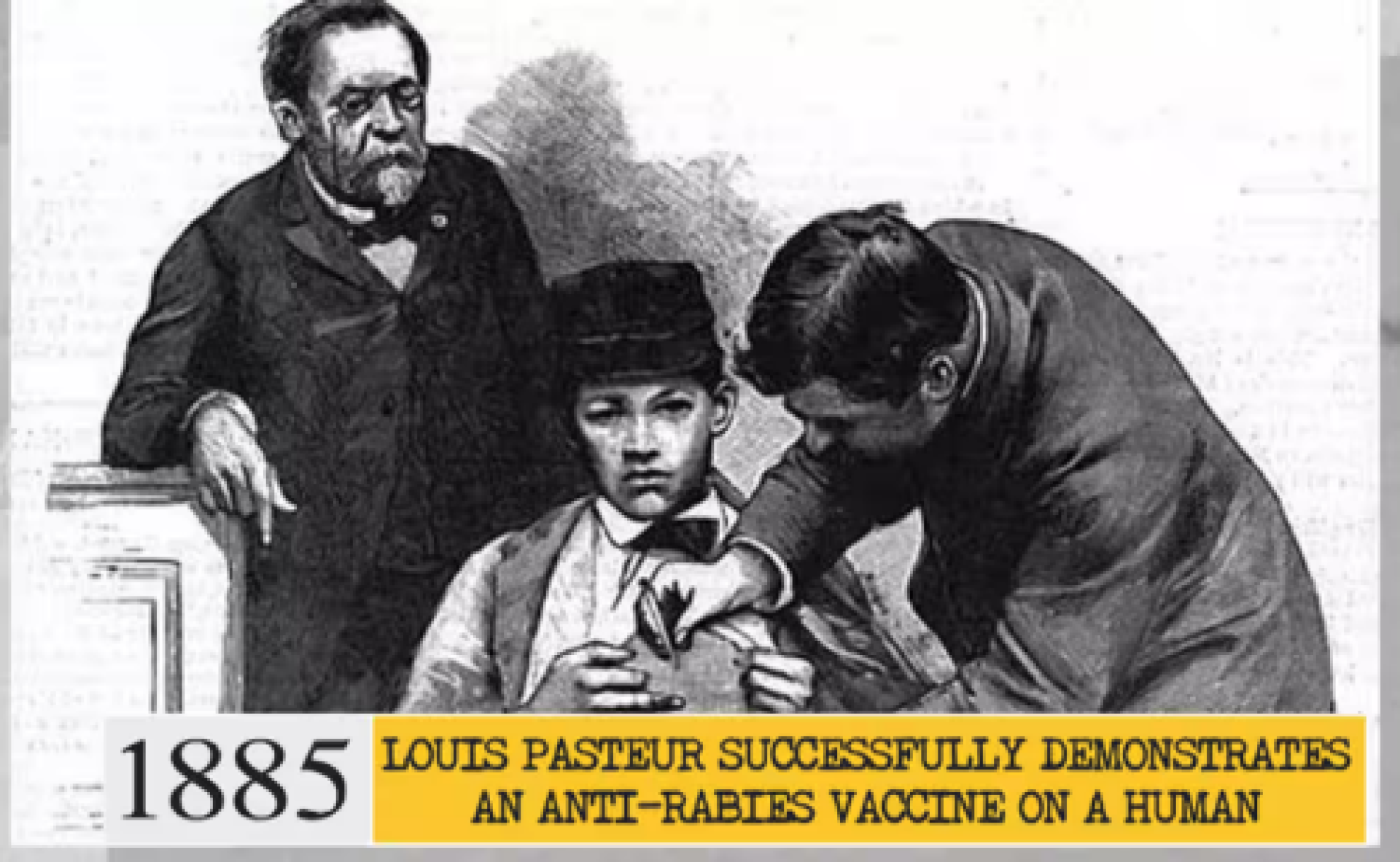When Was the Rabies Vaccine Invented? A Story of Scientific Breakthrough
Last updated: 20 Oct 2025
1470 Views

For centuries, a bite from a rabid animal was a terrifying and almost certain death sentence. The disease, with its horrifying progression, was one of humanity's greatest medical fears. There was no cure and no hope. That all changed in the late 19th century, thanks to the brilliant and determined work of one man.
The story of the rabies vaccine is not just a date in a textbook; it's a dramatic tale of scientific courage that laid the foundation for modern immunology. As a medical clinic dedicated to public health, we at Doctor Lamai Clinic believe in understanding the history behind the life-saving treatments we use every day.
This was not a planned clinical trial but a desperate, life-or-death gamble. The patient was a nine-year-old boy from Alsace, Joseph Meister, who had been bitten 14 times by a rabid dog. Knowing the boy faced certain death, his mother begged Pasteur to use his experimental new treatment. After consulting with medical colleagues, Pasteur agreed, marking a pivotal moment in the history of medicine.
To do this, he harvested the virus from the spinal cords of infected rabbits. He then exposed the spinal cords to air in sterile jars, a drying process that gradually reduced the virulence of the virus. For Joseph Meister's treatment, Pasteur administered a series of 13 injections over 11 days, starting with the most weakened, 14-day-old sample and progressing to fresher, more virulent material. The boy's immune system successfully built a defense, and he made a full recovery, living a long life.
Of course, medical science has advanced significantly since 1885. The original nerve-tissue-derived vaccines have been replaced by modern cell-culture vaccines, which are far safer, more effective, and require fewer injections.
We are proud to be a link in this long chain of medical progress, offering WHO-approved cell-culture vaccines to travelers and residents. The courage of 1885 inspires our commitment to providing clear, compassionate, and life-saving care today.
The first human to be successfully treated with the rabies vaccine was a nine-year-old French boy named Joseph Meister on July 6, 1885.
Was Louis Pasteur a doctor?
No, Louis Pasteur was a highly respected chemist and microbiologist, but he was not a licensed medical doctor. This made his decision to treat a human patient incredibly bold and controversial at the time.
Is the original rabies vaccine still used today?
No. Pasteur's original method of using dried rabbit spinal cords is no longer practiced. It was replaced decades ago by modern cell-culture vaccines that are much safer, more potent, and more reliable to produce.
Did the first vaccine have side effects?
The early nerve-tissue vaccines that followed Pasteur's work carried a higher risk of serious neurological side effects. This is a key reason they were replaced by today's much safer cell-culture vaccines.
How did Pasteur test his vaccine before using it on a human?
Before treating Joseph Meister, Pasteur had conducted extensive and successful experiments, demonstrating that his vaccine could reliably protect dogs from rabies even after they had been bitten by an infected animal.
The story of the rabies vaccine is not just a date in a textbook; it's a dramatic tale of scientific courage that laid the foundation for modern immunology. As a medical clinic dedicated to public health, we at Doctor Lamai Clinic believe in understanding the history behind the life-saving treatments we use every day.
The Answer: A Historic Day in 1885
The first successful rabies vaccine for a human was administered by the renowned French scientist Louis Pasteur on July 6, 1885.This was not a planned clinical trial but a desperate, life-or-death gamble. The patient was a nine-year-old boy from Alsace, Joseph Meister, who had been bitten 14 times by a rabid dog. Knowing the boy faced certain death, his mother begged Pasteur to use his experimental new treatment. After consulting with medical colleagues, Pasteur agreed, marking a pivotal moment in the history of medicine.
The Mind Behind the Breakthrough: Louis Pasteur
Louis Pasteur (1822-1895) was not a medical doctor but a chemist and microbiologist. His revolutionary work on germ theory had already transformed science by proving that microscopic organisms were responsible for diseases and decay. He had previously developed vaccines for chicken cholera and anthrax, but tackling rabiesa virus that attacks the brainwas his greatest challenge.How Did the First Rabies Vaccine Work?
Pasteur's method was both ingenious and rudimentary by today's standards. He theorized that he could create a "weakened" or attenuated form of the rabies virus that would trigger an immune response without causing the deadly disease.To do this, he harvested the virus from the spinal cords of infected rabbits. He then exposed the spinal cords to air in sterile jars, a drying process that gradually reduced the virulence of the virus. For Joseph Meister's treatment, Pasteur administered a series of 13 injections over 11 days, starting with the most weakened, 14-day-old sample and progressing to fresher, more virulent material. The boy's immune system successfully built a defense, and he made a full recovery, living a long life.
The Legacy of 1885: From Pasteur to Modern Medicine
Pasteur's success was monumental. It was the first time a vaccine had been used as a post-exposure treatmentthat is, given after a person was infected to stop a disease from developing. This single event launched a new era in medicine and led to the establishment of the world-famous Pasteur Institute.Of course, medical science has advanced significantly since 1885. The original nerve-tissue-derived vaccines have been replaced by modern cell-culture vaccines, which are far safer, more effective, and require fewer injections.
Honoring Pasteur's Legacy at Doctor Lamai Clinic
Over 140 years later, the principles established by Louis Pasteur continue to save countless lives every day around the globe. At Doctor Lamai Clinic in Koh Samui, we honor this incredible legacy by providing the most advanced and safe versions of the rabies vaccine available.We are proud to be a link in this long chain of medical progress, offering WHO-approved cell-culture vaccines to travelers and residents. The courage of 1885 inspires our commitment to providing clear, compassionate, and life-saving care today.
Contact Doctor Lamai Clinic for Modern Vaccination Needs
For a consultation regarding travel vaccines or for emergency post-exposure care, please contact our medical team.- Address: 124/254 Moo.3, Lamai beach, Koh Samui, Surat Thani, 84310
- Hours: Open Every Day from 9:00 AM to 7:00 PM
- Phone or WhatsApp: +66 65 262 9396
- Email: doctorlamaiclinic@gmail.com
- Map Link: https://maps.app.goo.gl/ejRpjTsi1mdhFJY88?g_st=ipc
Your Questions Answered: FAQs About the Rabies Vaccine's History
Who was the first person to receive the rabies vaccine?The first human to be successfully treated with the rabies vaccine was a nine-year-old French boy named Joseph Meister on July 6, 1885.
Was Louis Pasteur a doctor?
No, Louis Pasteur was a highly respected chemist and microbiologist, but he was not a licensed medical doctor. This made his decision to treat a human patient incredibly bold and controversial at the time.
Is the original rabies vaccine still used today?
No. Pasteur's original method of using dried rabbit spinal cords is no longer practiced. It was replaced decades ago by modern cell-culture vaccines that are much safer, more potent, and more reliable to produce.
Did the first vaccine have side effects?
The early nerve-tissue vaccines that followed Pasteur's work carried a higher risk of serious neurological side effects. This is a key reason they were replaced by today's much safer cell-culture vaccines.
How did Pasteur test his vaccine before using it on a human?
Before treating Joseph Meister, Pasteur had conducted extensive and successful experiments, demonstrating that his vaccine could reliably protect dogs from rabies even after they had been bitten by an infected animal.
References
For more detailed historical and scientific information about Louis Pasteur and the invention of the rabies vaccine, please consult these authoritative sources:Related Content


